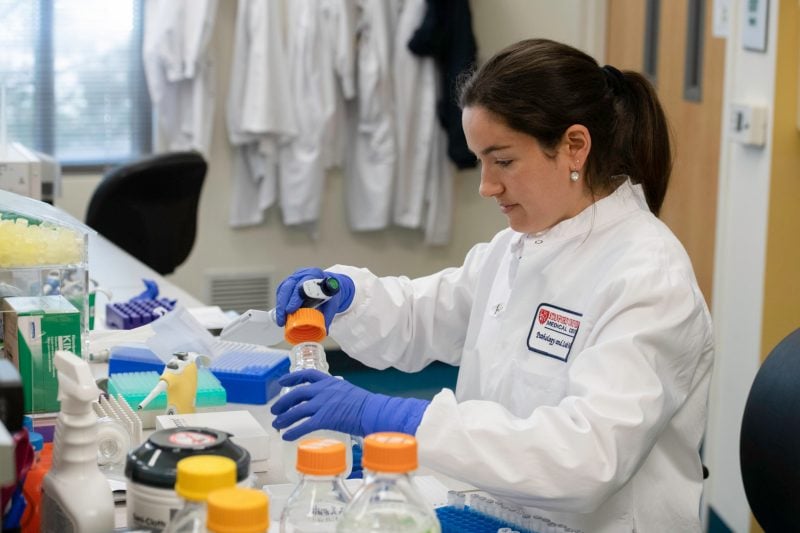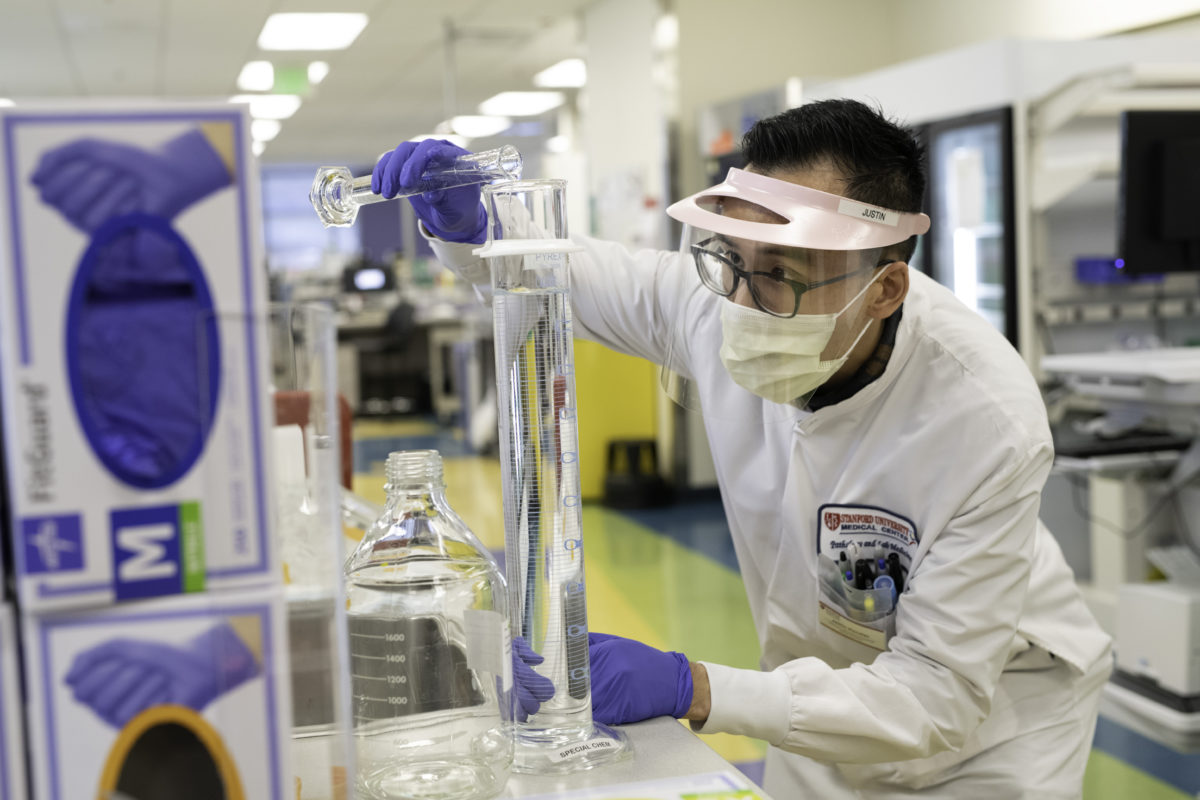Courtesy of Steve Fisch
Stanford announced on April 10 that it had developed an in-house antibody test that could detect the presence of antibodies for SARS-CoV-2, the virus responsible for COVID-19. Behind the scenes, there was unprecedented collaboration between researchers at Stanford that made it possible to develop an antibody test with such rapid turnaround.
To better understand the scientific collaboration that took place at Stanford, The Daily interviewed four scientists involved in the effort: Scott Boyd, associate professor of pathology; Jennifer Cochran, chair of bioengineering; Peter Kim Ph.D. ’85, professor of biochemistry; and Ted Jardetzky ’82, professor of structural biology.
“The pandemic has been the first time that many of us in our lifetimes have seen such a coordination of efforts from entire research communities, not only at Stanford,” Cochran said.
From the beginning, the researchers’ goal was to develop a fully in-house serological assay, or an assay that detects for the presence of antibodies, that would allow the University to conduct testing for the next six months to a year.
“We wanted to create our own tests so that we wouldn’t be beholden to the supply chain,” Cochran said.
These scientists, along with others, worked together to develop an antibody test that could detect the immune system’s response to the coronavirus, as a complement to diagnostic tests. Traditional diagnostic tests look for the genetic material of the virus, using methods such as polymerase chain reaction (PCR).
However, a shortage in the supply of the reagents necessary for these tests prompted researchers at Stanford to develop their own reagents and in the process, an entirely new in-house assay, or test.
“We made the decision to develop our own assay from the building blocks because we were unsure whether there would be enough supply for the testing we wanted to do,” Boyd said.
What followed was an intimate collaboration between Stanford several laboratories, forged by the demand created by the pandemic. Each researcher contributed their own expertise and leveraged their resources to make it possible to create a working antibody test in two weeks.
Jardetzky’s expertise in protein biochemistry and past work with Boyd made him an ideal collaborator. Jardetzky’s lab studies the structure and mechanism of viruses, with a focus on the herpes virus and mechanisms of the allergic response.
“Scott and I have been working together on a couple of other projects related to different viruses,” Jardetzky said. “Back in March, he approached me and asked if we would be interested in helping out in developing an antibody test locally at Stanford.”
Together, Boyd and Jardetzky set out to generate protein antigens, or parts of the coronavirus. For an antibody test, an antigen — or the pathogen that triggers the immune response — is essential to trigger the response from antibodies.
“One of the first things we did was identify with Scott what pieces of the virus we wanted to make,” Jardetzky said. “We were interested in looking at cross reactivity across the coronavirus, including some of the ones which are normally circulating and associated with the common cold.”
Three of the researchers interviewed mentioned a key early lead from a research group in New York: Florian Krammer’s laboratory at the Icahn School of Medicine at Mount Sinai. Krammer’s lab had already produced the plasmids that could make the coronavirus spike protein, the main surface protein that the virus uses to bind to a receptor.
“The group was very generous in distributing the plasmids that contain that gene to some of the labs at Stanford and elsewhere that allowed people to get a head start producing the protein themselves,” Boyd said.
Separately, Kim’s group also took action on the information provided by the Mount Sinai laboratory.
“When the pandemic broke out, we were interested in trying to help develop simple antibody testing,” Kim said. “As we were getting started, someone named Florian Krammer published a preprint which described the plasmids for the expressions of the antigen.”
Kim’s group requested some of the reagents from Krammer’s laboratory and began to initiate production of the proteins. After receiving the plasmids in late March, Kim’s lab worked on developing an Elisa test, which detects for the presence of proteins using antibodies. Once the test was validated using patient samples, they handed it over to Boyd’s group, which made sure it could work in the clinical setting.
It soon became clear that several laboratories at Stanford were involved in parallel efforts. Thomas Montine, chair of the department of pathology, identified these different groups and convened Zoom meetings, where everyone knew exactly what everyone else was doing. The laboratories had an all-hands-on-deck coordination meeting towards the end of March.
“From that point on, a kind of an organic level of communication between laboratories happened,” Jardetzky said.
At this stage, the laboratories began to communicate closely about how to effectively divide the work in order to move things forward quickly and avoid working on overlapping tasks.
“We’re basically taking parallel efforts and trying to merge them into really a combined effort and and get something to pathology [Scott Boyd] as quickly as possible so they could develop the test,” Jardetzky said.
With restrictions on activities allowed on campus, it made more sense for the researchers to work with an industry partner with expertise at scaling.
Cochran helped the team work with industry to scale up production of reagents.
“One of the things that I got involved with was reaching out to a network of industry partners to help secure manufacturing of critical reagents that we needed for the antibody tests,” Cochran said. “We didn’t want to be in a situation where we developed this wonderful test and then not have the reagents to use it.”
In fact, it was a shortage of reagents that stymied the availability of commercial coronavirus testing during the early stages of the pandemic.
Through Cochran, Stanford partnered with the biotechnology companies ATUM and Agilent for large-scale, high-quality manufacturing of the protein reagents needed for antibody testing.
“ATUM went above and beyond to optimize the protein production methods that were used to meet the urgency and stringency of the testing needs for the trials,” Cochran said. “Our long-standing partnership with Agilent helped us quickly mobilize coordination of key reagents for antibody detection.”
The efforts of graduate students across laboratories at Stanford also helped fuel the search for an antibody test.
“Katharina Röltgen was probably the most important person in developing the clinical assay,” said Boyd of a postdoc in his lab. “She and I worked many long hours in a couple weeks to get everything up and running.”
Likewise, Kim praised a postdoc in his lab for taking the initiative to start developing an assay and working hard to see laboratory work to completion.
“Abigail Powell in my lab sent me an email right away saying that this [Krammer’s paper] was just published. We wrote to him and he immediately said he’d be happy to send us the reagents,” Kim said. “[Abigail] is really the one who’s the hero. Here she managed to get this all up and running. I can’t give her enough credit. She really did a terrific job of working under pressure.”
Graduate students and principal investigators alike were motivated by the urgent need for testing created by the pandemic, which established a common goal for the researchers.
“When this whole pandemic hit with such severe consequences, we all felt like we should be able to do something,” Jardetzky said. “When we had that opportunity to really mobilize and to do something with the skill set that we have, I think people were so incredibly enthusiastic to just jump into that.”
All of the researchers interviewed expressed their appreciation of the collaborative spirit that has animated their research, as they worked towards a shared purpose to get the antibody test ready for healthcare workers and eventually the public.
“It’s pretty unprecedented and all coming together in a short period of time to rapidly advance solutions for diagnosing, preventing and treating disease,” Cochran said. “It’s been really powerful to see what we are able to accomplish with the scale of coordination of efforts like this.”
“Stanford has interdisciplinary collaboration in its DNA. That’s just part of our culture,” she said. “I think at Stanford, it’s very natural for us to all come together, roll up our sleeves, and pitch in with our expertise to make something happen.”
Contact Annie Chang at annie215 ‘at’ stanford.edu.

